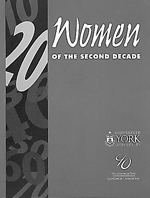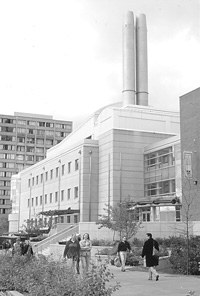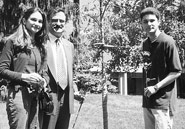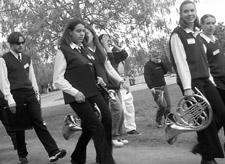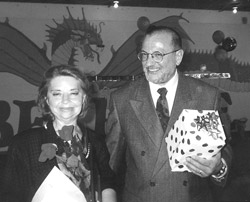 |  |
| | |
| | VOLUME 29, NUMBER 33 | WEDNESDAY, JUNE 9, 1999 | ISSN 1199-5246 | | |
|
| |||
|
|
Women of the Second Decade, a publication launched this spring at York, is the brainchild of Gill Tieman, special assistant to the president (Equity), and comprises the profiles of York women featured in The Second Decade, the newsletter of the Status of Women Office from 1986 to 1995. For Tieman, this project has been a labour of love. "It is very illustrative of the diversity of women at York in many ways," she said. "In ethno-racial makeup, part-timers, women with disabilities, and two individuals - Vivian James and Julia Oleszko - who, in 1986, had been at York for 25 years." Naomi Black, who created the popular newletter and had the original idea to profile women at York on the back page of each issue, wrote the introduction to Women of the Second Decade. According to Black, the newsletter began following the 10 year reassessment of the status of women at York in 1985 and from that benchmark, took its name. "The feather in our cap...was the profiles on the back page of the paper," Black said. "We were lucky: after two rather conventional interviews of far from conventional women, we were able to have the services of Christine Donald, who took over as the editor of the newsletter and conducted and wrote up the interviews. Donald is an editor and a poet, as well as an experienced community activist. The whole of The Second Decade shows the results of her intelligent devotion...." A number of the women profiled in Women of the Second Decade were present at its launch this spring and included women still at York, and others who have moved on. Each one signed a copy of the publication for the University. The list of those profiled is impressive: Vivian James, Nancy Mandell, Julia Oleszko, Michèle Glassford, Ellen Hoffmann, Elaine Glossop, Shelah Alleyne, Malini Singh, Marina van der Merwe, Sharon Nieforth, Selma Zimmerman, Neita Israelite, Venier Wong, Pam MacDonald, Nancy Hatch, Margaret Leung, Beth Hopkins, Bessie Himmelfarb, Thérèse How, Barbara Tomlinson, Cynthia Dandy, Shirley Williams, Susan Eastwood, Vered Pittel, Maria Pia-Verrelli, and Didi Khayatt.
| ||
|
|
Development of York's Department of Physics and Astronomy
(The following is a brief adaptation of a history of York's Department of Physics and Astronomy by York Professor Ralph W. Nicholls, published in the January/February issue of Physics in Canada.) The growth and early history of the department [of Physics and Astronomy] from 1965 was parallel to the development of the main York Campus and its program, including the establishment of the Faculty of Science of which it is part. One of the unique characteristics of the York curriculum has been the General Education Program whereby every student, irrespective of eventual specialization, before graduation must be exposed to appropriate "gen. ed." courses in Natural Sciences, Social Sciences and the Humanities, taken mostly during the Freshman and Sophomore years of study. This interdisciplinary ethos was actively advanced by founding President Murray G. Ross, and organized and put into practice by such faculty members as Professor Ralph W. Nicholls, who arrived from the University of Western Ontario as Senior Professor of Physics, and assumed the position of founding Chair of Physics at York in 1965. In July of that year, Nicholls was able to consolidate appointments of the founding department members, and after a brief "staging" period at Glendon College (where he temporarily set up his shock tube spectroscopy laboratory), the Department of Physics moved in August into the not-yet-completed Farquharson Science Building on the main York campus. It also housed the biology and chemistry departments. By 1968, the Department of Physics moved into the new, large, Petrie Science Building; it has been the department's "home" ever since.
"Some founding members of the physics and chemistry departments had a presence in the space science programs of Canada and NASA." - Nicholls The building of a new physics department and a new University was an exciting challenge. There was no "past history" to impede the adoption of imaginative and non-traditional concepts. This was a unique opportunity to establish a unique character for the new department, both from the standpoint of research interests, and also for undergraduate and postgraduate education. Many of the founding members had been dissatisfied in their previous institutions with the calibre of the mathematics teaching of physics students, which was often looked on as the "mere" service teaching by the mathematics departments. Thus from the start the department assumed the responsibilities for the mathematic teaching of York physics (and other science) students in Mathematical Methods courses which eventually evolved into the Applied Computational and Mathematical Sciences (ACMS) honours (and joint honours) degree option. The teaching of mathematics by certain physicists continued for 25 years; it also enabled the department to make some truly excellent appointments in theoretical physics over the years. In consolidating what areas of research concentration should be adopted by the department in its early days, it was decided to concentrate on a few fields. Thus the department recruited people with experimental, theoretical, (and where appropriate observational) research interests, in atomic, molecular and chemical physics, spectroscopy and optics, space and atmospheric science, and astronomy and astrophysics. Over the years these activities have been augmented to include geophysics, remote sensing, condensed matter and surface physics, and particle physics. Some founding members of the physics and chemistry departments had a presence in the space science (including rocket) programs of Canada and NASA before they arrived at York. They also brought graduate students and postdoctoral fellows to the University. It was thus decided, in early planning discussions during 1964, to establish in 1965, in addition to graduate programs in physics and in chemistry, an interdisciplinary research centre: The Centre for Research in Experimental Space Science (CRESS), now the Centre for Research in Earth and Space Science, to support collaborative research activities in atmospheric and space science and space astronomy of the members of the physics and chemistry departments. Since 1965, York University has graduated 100 CRESS MSc's and 110 CRESS PhD's, many of whom were supervised by physics and astronomy faculty members.
"The York Department of Physics and Astronomy approaches
Nicholls directed CRESS and its graduate program between 1965 and 1992. As part of his chairmanship of physics, he also set up and directed the physics graduate program during that period. The department's first PhD was Gordon Drake (1967), now the very distinguished Chair of Physics, FRSC, and co-editor of the Canadian Journal of Physics at the University of Windsor. During the past decade, in addition to holding memberships in a number of international Research Consortia, and Space Science Teams, numerous departmental members have also been instrumental in the establishment of and participation in the running of two Centres of Excellence, one Provincial and one Federal. The Provincial Centre of Excellence, the Institute for Space and Terrestrial Science (ISTS), was planned at York in 1986 by members of CRESS. After an exciting childhood and adolescence, some of which is reviewed above, the York Department of Physics and Astronomy approaches its maturity in the early years of the 21st Century with great confidence and anticipation. During the past 32 years, the department has learned a great deal about survival and growth in an environment of rapidly changing operational boundary conditions such as provincial university funding and the changing perception of physics by society and the strong demand by governments for more emphasis on utilitarian activities by physicists, more closely coupled to the stimulation of economic growth, and production of products and concepts useful to industry. Canada can ill afford not to provide its highly educated physicists with the opportunity to build satisfying careers in the 21st Century. Despite certain operation boundary conditions, York University is committed to hiring the finest physicists in the country, in addition to producing highly educated graduates.
| ||
|
|
By Cathy Carlyle Relax. The young scientists are out there, toiling to find the questions that are giving you sleepless nights...questions such as, How many moles of CO2 are there in the polar caps of Mars; how many dandelion seeds are produced annually in Ontario; and what would the area of a circle be (m2), if all the toothpaste used in Canada each year were to be squeezed out to form a continuous circumference? These are a few of the Fermi questions posed at York University's 20th annual Science Olympics, originated by Keith Aldridge, professor of geophysics, Faculty of Pure and Applied Science. In case you are wondering what a Fermi question is, it asks for a quick, rough estimate of something which is difficult or impossible to measure. The estimated 690 students from 46 Ontario high schools that registered were at a fever pitch to get going on the work ahead of them. They cheered their own teams as names were announced, they dashed to their stations when the time was right, they sped around the campus in high spirits throughout the day. Some carried balloons. All wore smiles. They had more than questions over which to puzzle. There was the bio-steeplechase, where students competed to answer multiple choice questions located at a series of tables ('hurdles'). They had plants to identify, animal skulls to name - and the race was on. Teams participating may not have been horses, but they were champing at the bit to be the first to answer all the questions. One of the newer categories, initiated in 1996, was the www scavenger hunt. As the name suggests, teams embarked on a scavenger-style hunt on the Web. Each team had access to two terminals running Netscape and they had to thread their way through links to a final destination, collecting certain bonus points where possible. At the compounds site teams were pitted against each other in a Scrabble™-style game. They were set the task of making up formulae of chemical compounds from a pack of cards, each of which had the name of an element or radical on it. At the water rockets site, crowds gathered to see which pop-bottle rockets, partly filled with water, would make it off the launch pad when given pressure from a bicycle pump. Just as in the NASA program, there were a few failures and lots of frustrations - but great successes, too. Hilarity mounted on the York Common as students, kitted in helmets, fired water-filled balloons from a giant rubber-tube catapult stretched between goalposts. They aimed at targets placed at various distances downrange on the field. In fact, students enjoying the challenges while cooperating with their teams seemed to be the order of the day. It was certainly what Aldridge hoped to see them doing. "When we began this Science Olympics I thought it would be a much more adrenaline-releasing experience for students than a science fair - which often proves to be short on science and fairness from my experience as a judge at those events. "Winners of our Science Olympics events are all determined by objective measures - usually mass, length or time. Students can actually see why they won or lost...Their rocket stayed up for two seconds longer than their competitors', for example. Students learn to think on their feet and often must act quickly, so it's like real life." Judges for the events were York faculty members and their graduate students. The winners were: First overall, Woburn CI; Second, UTS; Third, Brebeuf CI; tied for Fourth, Aurora HS and Stephen Leacock CI.
| ||
|
|
Constantine Georganas (centre), with his children Jaime (left) and Nicholas. Gloria Georganas, long-term employee at York and assistant to the Advisor for the University on the Status of Women for five years, was remembered at a touching ceremony in May, nearly a year after her death. Her husband, Constantine, and children, Nicholas and Jamie, were present at the planting of a white oak tree near Norman Bethune College to honour her. Dale Hall, advisor at the Sexual Complaint and Harassment Centre, quoted from a poem about planting seeds of love into other souls to bloom. She spoke of Gloria having planted many seeds of friendship while at York, and how they would "continue to grow and remind us of our co-worker and friend". She also mentioned that Gloria had spoken of her work with Status of Women as a "daily education in compassion and empathy, seeing the world through the eyes of other women". Gloria's husband spoke on behalf of himself and his children about how much York had meant in Gloria's life, especially as she and Constantine had met while students here. Each person present received a rose, and was asked to place it beneath the newly-planted tree. The ceremony was followed by a luncheon at which many people made tributes to Gloria Georganas.
| ||
|
|
By: Andrew McRae York was awash with musical talent as thousands of participants of Canada's MusicFest '99 descended on its grounds. Over 10,000 performers and participants, and as many as 40,000 parents and spectators from across Canada made the University their home from May 12-26, and filled the air with sounds from a plethora of musical instruments. While high profile performers such as the Canadian Brass were in attendance, the majority of participants were secondary school students from across the country. York presented 34 concerts, 77 hours of clinics and over 400 participating ensembles. Musical categories judged at the festival included concert bands/orchestras, jazz ensembles, concert/chamber choirs, instrumental combos, vocal jazz ensembles, and chamber ensembles. Youth was the unwritten theme of this year's MusicFest, as the National Youth Band of Canada (NYB) showcased its talents on May 19. The NYB is the Canadian Band Association's flagship project. Formed in 1934, its mission is to "promote and develop the musical, educational and cultural values of band music in Canada." For more than 60 years the association, with its nine provincial affiliates and more than 1,300 members, has strived to carry out this mandate. Hosted at York by York Hospitality, the music festival's principal corporate sponsors included Yamaha Canada, Canadian Airlines International, Rico International, and The Zildjian Company. Both Yamaha and Zildjian provided concert stages (erected at the Field House and Tait Mackenzie respectively) for headlining attractions to perform. Among these were three of the finest drummers and percussionists in the world: Steve Houghton, Gary Chaffee, and Johnny Lee Lane. Areas of concentration for concerts included all undergraduate residences, the Vari Hall Complex, the Music Department, Tait Mackenzie/Student Field House, Burton Auditorium, Joe Green Theatre, and the Fireside Lounge. MusicFest Canada provided the opportunity for outstanding individual participants to compete for up to $100,000 in scholarships at the York festival. Applications and tapes were submitted in April; the awards ceremony was hosted by Paramount Canada's Wonderland at the Kingswood Theatre on May 23. Whether one was a participant, a spectator, or on a music field trip for a day, MusicFest '99 was an entertaining and educational event that proved enjoyable for all involved. It was fitting that this year's music festival be held at York during the University's 40th anniversary celebrations. More so, that MusicFest '99 was hosted by one of Canada's most innovative universities for music studies.
| ||
|
|
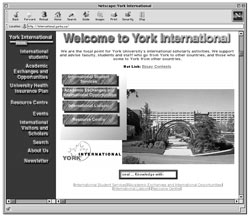
By David Finestone
After surfing through complicated and complex sites, landing on For the unenlightened, Y.I. is the focal point for York University's international scholarly activities. It supports and advises faculty, students and staff who go abroad from York, and those who come to York from other countries. The site effectively corrals information relevant to its mandate, from the York LAN and arranges it in an easily navigable frames environment (if your browser of choice is 2.0-5 or lower, its time for an upgrade). The following pseudo site-deconstruction exemplifies how well the info. is broken down into intuitive segments:
Check it out. The YI site may be your first step to learning more about York University's exchange program with universities worldwide. Anyone for a semester of study abroad?
| ||
|
|
By Andrew McRae Retiree Janice Book with York Registrar Ygal Leibu A bittersweet ending of enduring and loyal careers in the Registrar's Office (RO) has come about for seven members of the York family. Among the retirees - who collectively worked at the University for 157 years - four graduated from York, and several of them introduced family members into the York community. Nearly 300 invitees - including family members, friends, former registrars and colleagues of the retirees - were in attendance at the farewell reception held at the Norman Bethune College Dining Hall on April 7, 1999 to say goodbye and reminisce with Carol Duffy, Janice Book, John Spanhouse, Susan Lanoue, Grace Samuel, Lolita (Dottie) Johnson and Ray Rouleau. The seven retirees comprised over 10% of the staff complement in the RO. "Their departure opens gaping holes in the institutional memory and functional expertise which will be hard to fill," said Deborah Hobson, vice-president (Enrolment and Student Services), adding, "the entire event was both joyful and bittersweet, and a marvellous manifestation of the collegiality and mutual support which characterizes the RO." As York opens new chapters in its unfolding saga after forty years in operation, the RO also turns a page in its future as it bids farewell to seven members of its family. They will be remembered for many years to come. Janice Book: coordinator, Advanced Standing Unit, 1969-1999. Janice is an animal lover par excellence. She is heading to Winnipeg where she will soon be enjoying her house, garden, and being in the true centre of Canada. Her colleagues will miss her list of sunrises and sunsets, which always gave hope that the dark winter was ending, and a spring reborn. Carol Duffy: coordinator, Degree Audit Unit, 1974-1999. Carol earned a BA from the Faculty of Arts in English. She was the convocation officer in the Office of Student Programs (OSP) Arts until 1994 at which time she moved to the Registrar's Office. The RO bets that every florist in Toronto knows Carol's office address by memory; that is the frequency by which she received flowers from students. Devoted to her family, she is a doting mother and grandmother. The rest of the RO aspire to her level of dedication to York, its students, and the staff who have been trained by Carol to deliver excellent student service. Lolita (Dottie) Johnson: Information Services Unit, 1973-1999. Dottie managed to balance family life, work, and obtain a York BA degree which she completed with Honours in Sociology in 1991. Dottie is also a published and accomplished poet. Susan Lanoue: administrative officer, 1975-1999. Susan emigrated to the Yukon from Scotland on her own in her mid-teens, and started out with the Royal Canadian Mounted Police. She then moved to Montreal where she learned the French language with a Scottish brogue. While working at York as a secretary, she completed a BA at Glendon in June 1991, majoring in English. She managed this while working and raising a child. Susan has been an active volunteer on the Muirhead Foundation, which awards prestigious scholarships to deserving students headed for university. She is a proud mother of three, and grandmother of one (with another soon expected). Susan is excited to branch out in her retirement and set new challenges for herself. Ray Rouleau: Courier Services (Records Unity), 1988-1999. Ray is a pilot, who has lived at the D.E.W. (Distant Early Warning) line, and knows Canada and its peoples intimately. Ray is dearly loved throughout the RO and across the campus. Grace Samuel: Enrolment Unit, 1974-1999. Grace is very family oriented and is looking forward to spending more time with her loved ones, particularly those in Washington, Ocean City and Atlantic City, where she will retire. Last year in Washington, Grace attended a Christmas Eve church service with the First Family of the United States. John Spanhouse: articulation officer, 1968-1999. An inveterate collector of a variety of things including stamps, menus, luggage labels, and aluminum, John has all of his report cards since Grade 1, as well as his schoolwork, toys and games. He loves second-hand bookstores, and intends to do some genealogical research. He is the fifth generation of Spanhouses to be named John.
| ||
|
|
By L. Anders Sandberg, Raymond A. Rogers and Catriona A.H. Sandilands Opinion The Gazette solicits and accepts opinion pieces for publication, based on their relevance to the University and related topical issues. Rejection may be made of commentaries that do not comply with the law of libel, or which could seriously damage the reputation of any individual or York University. Articles should be no longer than 650 words in length and, if possible, provided on disk. Submissions should reach the Gazette 15 days prior to publication date. For the past decade of so, the environmental policy process in Canada has been marked by increasing conflict and discord, and when agreements have been hammered out, there remains a general sense of dissatisfaction among participants involved in the policy process. The recent Lands for Life deal is no exception. It is an example of "chronic crunch-time" conservation, given the divergence of opinions that have been expressed in the aftermath of the final deal in the "Lands for Life" process. Since 1997, the provincial Conservatives have worked towards developing a forest-lands-use and preserved-areas plan for mid- and northern-Ontario, referred to as Lands for Life. Three round tables were appointed to develop and gather input from people in three different regions: the Great Lakes/St. Lawrence, Boreal East and Boreal West. The membership of the round tables was selected by the government prompting environmentalists to fear that the northern wilderness would be "sold out" to the logging, hunting and angling lobbies. After the round tables came out with their "consolidated recommendations" in October 1998, proposing protected wilderness areas be increased from six to eight per cent, the public response was critical. In December, a list signed by 1,252 scientists demanded government drop the proposals. A coalition of environmental groups, the "Partnership for Life" (consisting of the Wildlands League, the World Wildlife Fund, and the Federation of Ontario Naturalists), organized repeated protests on the recommendations. More radical groups, such as Earth Roots, staged spectacular events such as posters of a bald Mike Harris with the slogan "Don't Clear-cut Ontario's Forests". The reaction from industry was muted. Forest companies and forest worker unions followed a well-worn script, arguing the "wilderness is big enough for everyone". Since December the government has shown some flexibility. Shortly after secret meetings on the shores of Lake Couchiching among the government, major forest companies and Partnership for Life, a deal was announced. It set aside 12 per cent as preserved areas, with the prospects of even more preserves for unrepresented ecosystems. The deal was praised by both industry and the Partnership, but not by all environmental groups. The Globe and Mail editorialized that "by showing that a hard-headed, business-oriented politician can take a major leadership on environmental matters, [Harris] has opened the door to other government leaders who have been sitting on the fence, content with declarations of principles but reluctant to take on the special interests that vigorous environmental management might offend." But what does this compromise all mean? We suggest appearances may be deceiving, and the Lands for Life process may take forest conservation in a negative direction. The Conservative "deal" is part of a process of what we call neo conservation, and it is problematic on at least three counts. At the most elementary level, the deal is totally misleading on the part of the government. There was an appearance of consultation during the round table discussions, but opportunities for input were limited. The government-appointed round tables initially offered a "low ball" eight per cent recommendation in 1998, which is what caused the protests; then, in response, made a "backroom" deal with Partnership for Life, and now appears as the wilderness saviour. Since the agreement was struck, though, the government has announced it is considering allowing for system-wide changes to allow hunting and mineral exploration in the new parks and protected areas. Partnership for Life now objects to this provision, but its criticism pales in comparison to its initial hearty and vocal praise of the proposal. Its credibility has also been questioned by its willingness to engage in "backroom" deals with the government. The critical voices of environmentalists not included in the Partnership have fallen on deaf ears, while most of the public is in the dark about the process. And, crucially, Ontario's First Nations are especially critical of the deal since it completely ignores aboriginal treaty rights. This Neoconservation approach is also suspect because it brings a neoconservative business ethic to the wilderness. Although preservation seems to be about saving wilderness from commerce, it is important to pay attention to the importance given in the report to recreational access. And recreational access is not about nature; it is about business. Lands for Life is about attracting the spending dollars of wealthy southerners who are looking for a nature escape. Neoconservation is also suspect because it is part of a dominant discourse about nature, parks and protected areas generally. As the disagreements among environmentalists over the deal have shown, few environmental issues are solved by creating parks; parks have become mere means of appeasement for environmental protests, or worse, fronts for business as usual on all other forest lands and in all other capitalist respects. Neoconservation and the Lands for Life deal hides its business tracks behind a smoke screen of consultation, preservation and recreation. It fails to acknowledge the inherent value in all ecosystems and their processes. It also fails to rethink the dichotomy between industrialist "log it all" and preservationist "leave it all" values - both of which tend to serve wealthy southern constituencies. L. Anders Sandberg, Raymond A. Rogers and Catriona A.H. Sandilands are professors in the Faculty of Environmental Studies at York University.
| ||
|
|
By Cathy Carlyle There are the computer-consumed people of this world; then there are the rest of us, those wanting to know more about computers - needing to know for our work, perhaps. Until now, we've been thrown crumbs to keep us following the trail of the computer know-alls. An inservice here, a workshop there... The serious computer buffs have had it their way for a long time. Their raging thirst for programming and analysis courses continues to be quenched, but no longer at the expense of those of us who are more technologically challenged. At a news conference on May 3rd, York University launched three new Information Technology (ITEC) degree programs that are designed to deliver a broadly-based education related to the application of information technology in contemporary organizations and society. The first ITEC students will begin their studies in the fall of 1999. The University recognized that Canada's ITEC industry is growing rapidly, creating thousands of new jobs, yet universities in the country are producing only about half of the graduates needed in that field. In fact, industry experts say that 20,500 trained professionals in the field will be needed by the year 2005, more than double the current workforce. "Faculty and staff listened to students and employers," said York President Lorna Marsden. "Then they developed a vision and a curriculum in which computing is studied from the point of view of the users of technology, rather than from the traditional programming and systems engineering perspectives that characterize computer science programs. Today we celebrate the fruits of their work." Marsden said that York's mission is to respond to the needs of the local, provincial and national communities it serves. "The innovative ITEC programs demonstrate our ability to translate this commitment into meaningful action." The new programs are offered through three Faculties. The Faculty of Arts, Atkinson College, and Glendon College have the programs ready to go, each with core courses designed to facilitate student mobility and access to ITEC courses throughout the University. However, the programs differ in both emphasis and purpose. "Study in the Liberal Arts has always been concerned with issues of culture and technology," said Dean George Fallis, Faculty of Arts. "For instance, the social sciences and humanities have studied the social implications of the printed word and the technology of mass communications. This trend will continue with the new program, which is an extraordinary innovation. It has the creative combination of mathematics and information technology with courses in the humanities and social sciences." Fallis sees it as a program that will prepare students to enter the ITEC field as users' advocates who will be able to design and help implement technologies that work effectively. The Faculty of Arts ITEC program is formulated to provide students with the background and skills required to analyze critically the institutional and social implications of computer technology. Three- and four-year programs are available. In addition, there are specialized Honours degree options with concentrations in mathematics; and an Honours option in conjunction with other Honours Programs in the Faculty of Arts. Atkinson College, serving primarily adult and part-time students, will offer two types of ITEC degrees which may be taken on a full- or part-time basis in the late afternoons, evenings and on weekends. Correspondence and Internet courses will be available, too. "We are able to provide students who have work and family commitments with access to a university education 24 hours a day year-round," said Dean Ron Bordessa of Atkinson. "Today, and increasingly tomorrow, information technology lies at the centre of the processes of work. Graduates from our ITEC programs will be well-positioned to mediate commerce at the interface between machines and human beings. They will have technical proficiency which can be applied readily, and a critical awareness of the impacts of technological innovations on users. They'll also have the proper regard to the nexus of social, political, and economic policy issues embedded in advances in information technology." One of Atkinson's ITEC degrees is a BA in Information Technology with three distinct options: information technology and social issues; health informatics; and technical and professional writing. The second type of degree is a BAS (Honours). Glendon, York's bilingual college, will offer "a significant" part of the ITEC program in French, according to Associate Principal (Academic) John Crozier. He described the program as "an affirmation of and renewal for Glendon". "ITEC at Glendon will attract three main types of students: the computer science majors who have a broader and more general interest in the area; those who are doing majors in another field but want to combine their degrees; and those who would like to pursue information technology as a minor." Earlier, Principal of Glendon College Dyane Adam said she welcomed the creation of the ITEC program. "Information technology will prepare students for a satisfying career based on combining technical skills with the broader bilingual liberal arts foundation for which Glendon is famous." The College offers its program three ways: a three-year BA; a four-year combined Honours and Specialized Honours degree; and a double major degree with Information Technology and other Honours programs offered at Glendon. The new ITEC programs in the three faculties were developed in response to the Ontario government's Access to Opportunities Program, set up to encourage growth in computer-science related programs and high-demand engineering fields.
| ||
| | Current Issue | Previous Month | Past Issues | Rate Card | Contact Information | Search |
|
